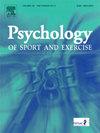Associations between moral disengagement and prosocial and antisocial behavior in sport: A systematic review and meta-analysis
IF 3.1
2区 心理学
Q2 HOSPITALITY, LEISURE, SPORT & TOURISM
引用次数: 0
Abstract
Objectives
The aim of this study was to summarize the available evidence on the extent of the association between moral disengagement (MD) and prosocial behavior (PB) and antisocial behavior (AB) in sport.
Design
A systematic review and meta-analysis.
Methods
Seven databases were systematically searched and literature screening. The CMA Version 3.3 was applied to estimate confidence intervals for the average effect sizes. The Q statistic and I-squared index were used to test for heterogeneity. Funnel plots, fail-safe numbers (Nfs), and Egger’s linear regression were used to analyze publication bias. Sensitivity analyses were used to identify outliers, and subgroup analyses and meta-regression were used to test potential moderators.
Results
Twenty-nine studies were included, and the results showed the negative correlation between MD and PB in sport was small in size (r = −0.22, 95 % CI [-0.30, −0.14]), while the positive correlation between MD and AB in sport was large in size (r = 0.53, 95 % CI [0.48, 0.59]). More specifically, MD was negatively correlated with PB toward teammates (r = −0.07, 95 % CI [-0.12, −0.01]) and PB toward opponents (r = −0.09, 95 % CI [-0.18, −0.01]), with very small effect sizes, but positively correlated with AB toward teammates (r = 0.43, 95 % CI [0.35, 0.51]) and AB toward opponents (r = 0.56, 95 % CI [0.49, 0.63]), with medium to large effect sizes. Subgroup analyses revealed that individualism-collectivism and sports type moderated the association between MD and AB.
Discussion
Mechanisms of moral disengagement were more strongly associated with antisocial behaviors than prosocial behaviors in sport. In the future, there is a necessity to conduct further research on non-contact sports and different subtypes of antisocial behavior using high-quality study designs.
体育运动中道德脱离与亲社会行为和反社会行为之间的关系:系统回顾和荟萃分析。
研究目的本研究旨在总结体育运动中道德脱离(MD)与亲社会行为(PB)和反社会行为(AB)之间关联程度的现有证据:方法:系统回顾和荟萃分析:对 7 个数据库进行了系统检索和文献筛选,并使用质量评估工具对纳入研究的偏倚风险进行了评估。采用 CMA 3.3 版估计平均效应大小的置信区间。Q 统计量和 I 平方指数用于检验异质性。漏斗图、故障安全数(Nfs)和 Egger 线性回归用于分析发表偏倚。敏感性分析用于识别异常值,亚组分析和元回归用于检验潜在的调节因子:共纳入 29 项研究,结果显示,运动中 MD 与 PB 之间的负相关性较小(r = -0.22,95% CI [-0.30,-0.14]),而运动中 MD 与 AB 之间的正相关性较大(r = 0.53,95% CI [0.48,0.59])。更具体地说,MD 与对队友的 PB(r = -0.07,95% CI [-0.12,-0.01])和对对手的 PB(r = -0.09,95% CI [-0.18,-0.01])呈负相关,效应大小很小,但与对队友的 AB(r = 0.43,95% CI [0.35,0.51])和对对手的 AB(r = 0.56,95% CI [0.49,0.63])呈正相关,效应大小为中等至大。分组分析显示,个人主义-集体主义和运动类型调节了MD和AB之间的关联:讨论:与体育运动中的亲社会行为相比,道德脱离机制与反社会行为的关系更为密切。今后,有必要采用高质量的研究设计,对非接触式运动和不同亚型的反社会行为开展进一步研究。
本文章由计算机程序翻译,如有差异,请以英文原文为准。
求助全文
约1分钟内获得全文
求助全文
来源期刊
CiteScore
6.40
自引率
5.90%
发文量
172
审稿时长
69 days
期刊介绍:
Psychology of Sport and Exercise is an international forum for scholarly reports in the psychology of sport and exercise, broadly defined. The journal is open to the use of diverse methodological approaches. Manuscripts that will be considered for publication will present results from high quality empirical research, systematic reviews, meta-analyses, commentaries concerning already published PSE papers or topics of general interest for PSE readers, protocol papers for trials, and reports of professional practice (which will need to demonstrate academic rigour and go beyond mere description). The CONSORT guidelines consort-statement need to be followed for protocol papers for trials; authors should present a flow diagramme and attach with their cover letter the CONSORT checklist. For meta-analysis, the PRISMA prisma-statement guidelines should be followed; authors should present a flow diagramme and attach with their cover letter the PRISMA checklist. For systematic reviews it is recommended that the PRISMA guidelines are followed, although it is not compulsory. Authors interested in submitting replications of published studies need to contact the Editors-in-Chief before they start their replication. We are not interested in manuscripts that aim to test the psychometric properties of an existing scale from English to another language, unless new validation methods are used which address previously unanswered research questions.

 求助内容:
求助内容: 应助结果提醒方式:
应助结果提醒方式:


